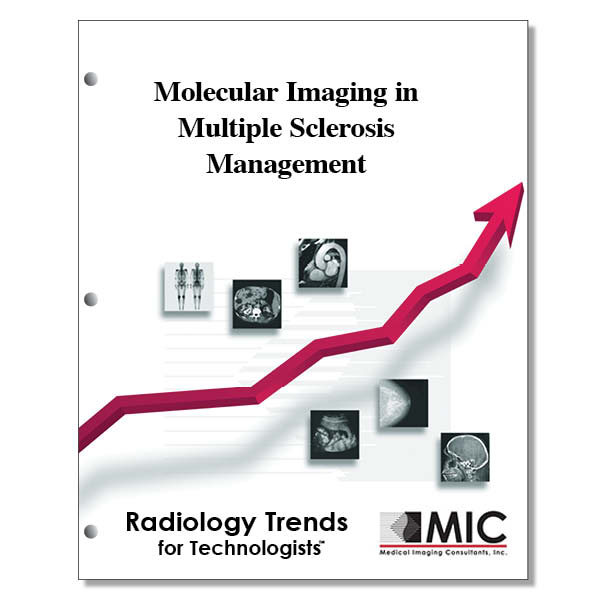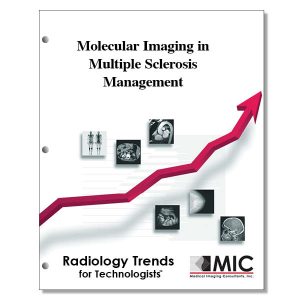

Molecular Imaging in Multiple Sclerosis Management
A review of the modalities used for molecular imaging of multiple sclerosis, and a discussion of the probes that are currently in development alongside therapeutic drugs that share their targets.
Course ID: Q00714 Category: Radiology Trends for Technologists Modalities: MRI, Nuclear Medicine, PET2.00 |
Satisfaction Guarantee |
$24.00
- Targeted CE
- Outline
- Objectives
Targeted CE per ARRT’s Discipline, Category, and Subcategory classification:
[Note: Discipline-specific Targeted CE credits may be less than the total Category A credits approved for this course.]
Magnetic Resonance Imaging: 0.50
Procedures: 0.50
Neurological: 0.50
Nuclear Medicine Technology: 0.50
Procedures: 0.50
Other Imaging Procedures: 0.50
Registered Radiologist Assistant: 0.50
Procedures: 0.50
Neurological, Vascular, and Lymphatic Sections: 0.50
Outline
- Introduction
- Clinical Imaging Modalities
- MRI and MRS
- PET and SPECT
- Biomarkers of MS Targets
- Small Molecule Probes and Nanoparticles
- In Situ-Labeled Cells
- Imaging Agents Based on Established Therapeutic Drugs
- Clinical Trial End Points
- 1H MRS
- TSPO Imaging
- Conclusion
Objectives
Upon completion of this course, students will:
- describe the pathophysiology of multiple sclerosis
- list the clinical imaging modalities used to evaluate patients with MS
- list the MRI pulse sequences that guide MS treatment management
- compare the specificity and sensitivity of MRI and PET for specific targets of MS
- list the MRI pulse sequences with higher pathologic specificity that are used as clinical trials outcome measures
- list the isotopes that have been evaluated with MRI and MRS
- describe the application of gadolinium-based contrast agents in patients with MS
- describe techniques for monitoring immune cell trafficking at MRI
- describe the utility of NAA levels at 1H MRS
- identify recent technical advances for PET that can improve spatial resolution
- describe the physical half-life of PET radiotracers
- identify the imaging modality that has been sparsely explored for applications in patients with MS
- describe the application of small molecule probes in monitoring MS pathophysiology
- identify the molecular target evaluated with 18F-radiolabeled FDG
- list the molecular targets evaluated with 11C-radiolabeled PET probes
- list the molecular targets evaluated with gadolinium-based contrast agents
- describe obstacles for developing and translating targeted molecular imaging probes for MS applications
- list the imaging modalities used for preclinical imaging of ICAM-1 and VCAM-1
- describe the MRS technique for preclinical investigation of glucose uptake and metabolism
- list MS therapies that are associated with alterations in glucose utilization
- identify the PET probe that produces the highest uptake in MS lesions
- identify the cell type that is believed to play the most prominent role in driving MS pathogenesis
- list the circulating immune cells that are labeled using ultrasmall superparamagnetic iron oxide particles
- describe the MRI technique for assessment of mononuclear phagocytic cells
- identify the serotonin receptor antagonist that attenuates EAE disease severity in animal models
- identify the most widely developed COX-2 inhibitor that attenuates paralysis in multiple MS models
- identify the FDA-approved potassium channel blocker used in patients with MS
- list the isotopes used to radiolabel rituximab for PET imaging
- describe the technique used to image 19F-labeled teriflunomide
- list conventional imaging metrics commonly used to evaluate therapeutic efficacy in MS clinical trials
- describe the most extensively characterized technique for monitoring metabolic brain changes
- identify the brain chemical affected by interferon-β therapy
- list the isotopes used to radiolabel TSPO-targeting PET probes
- identify the most extensively developed molecular imaging target in MS
- identify the only TSPO PET tracer used for side-by-side comparison of MS treatments
